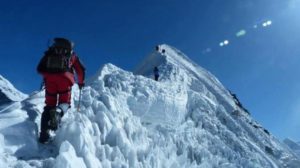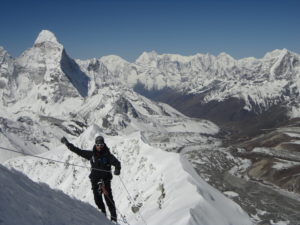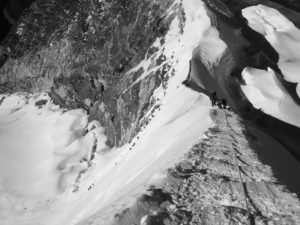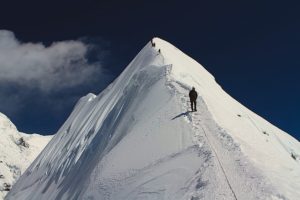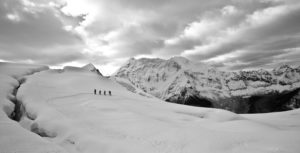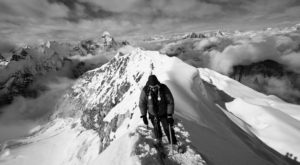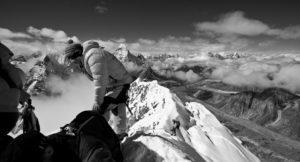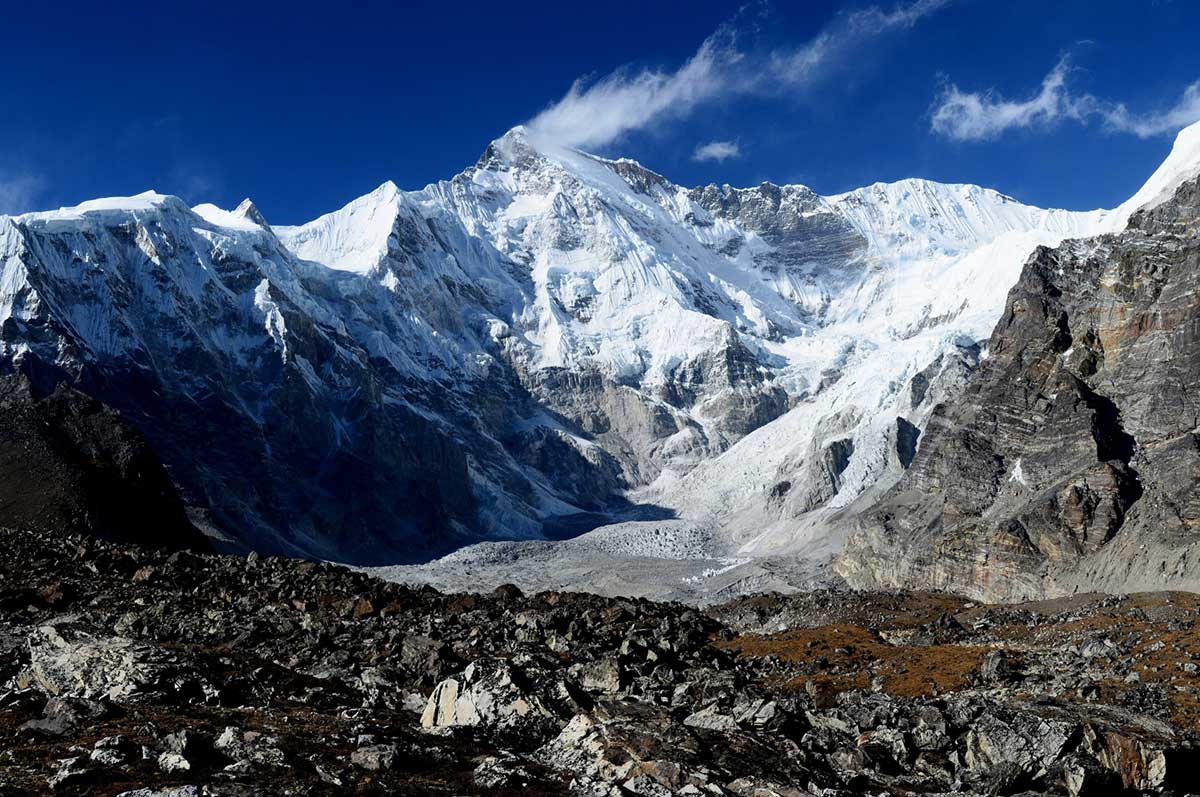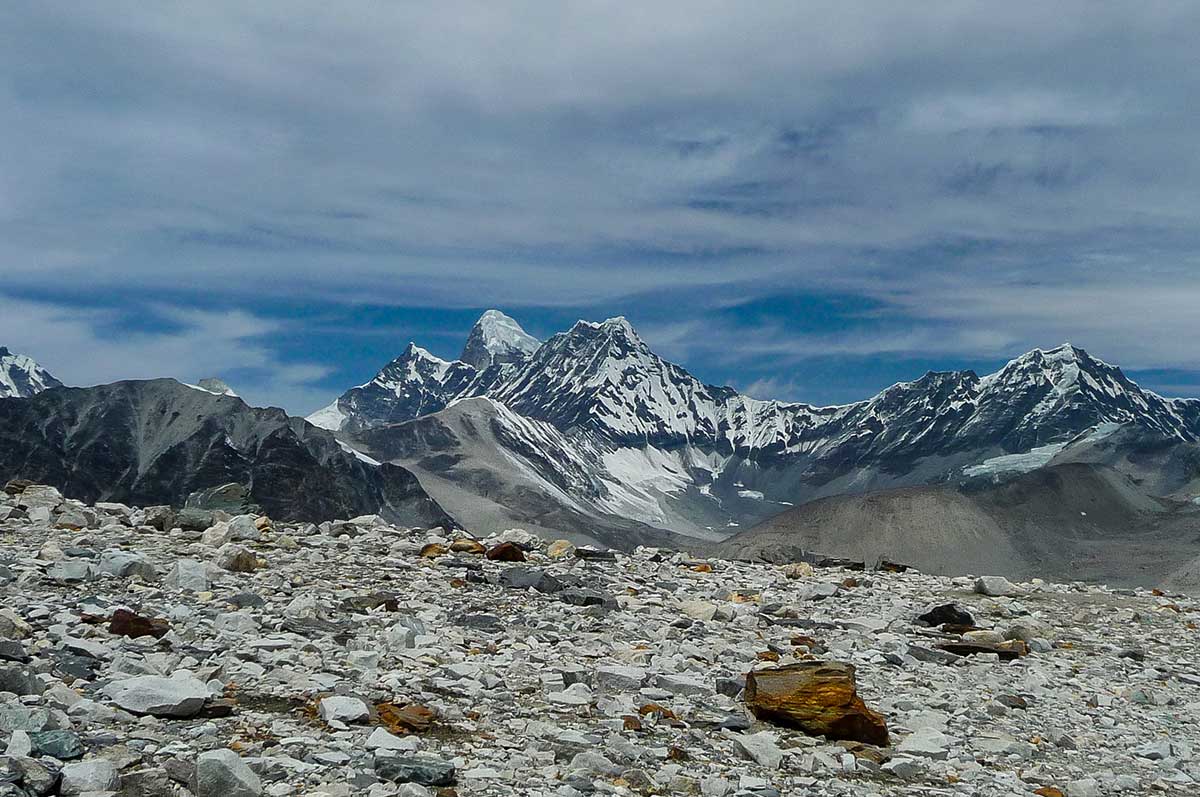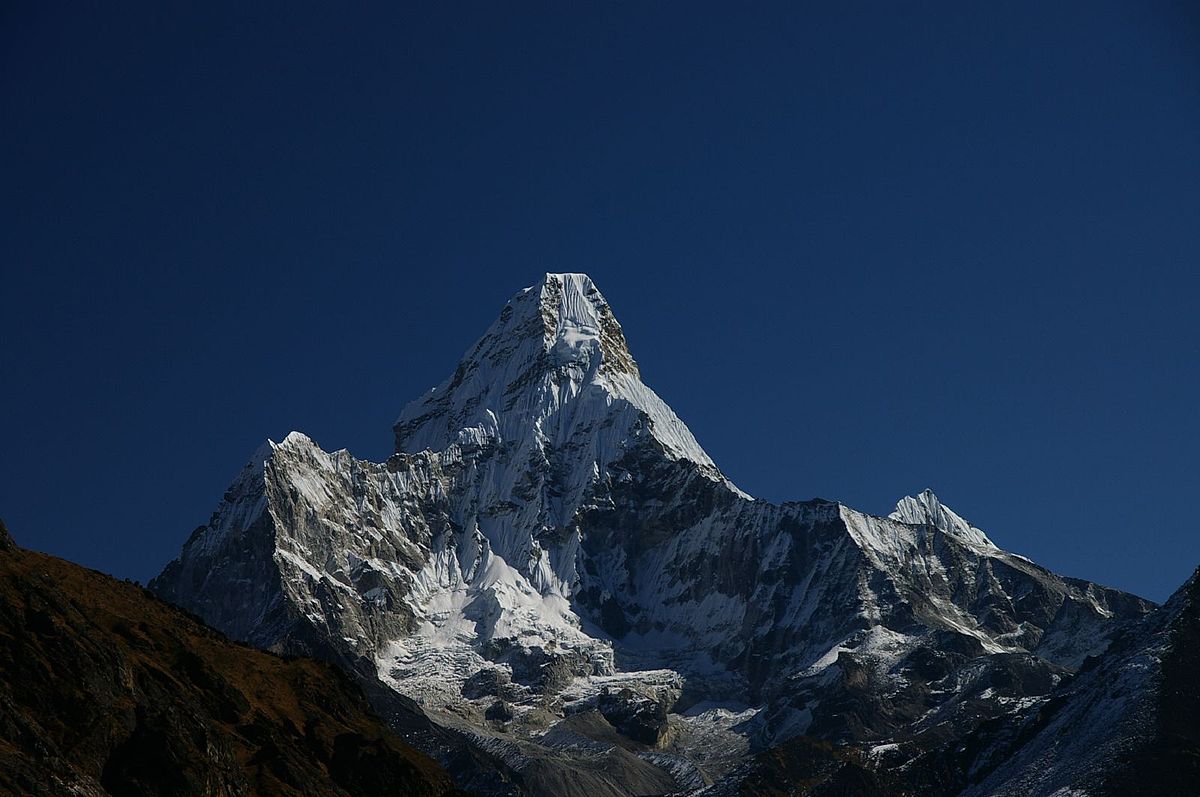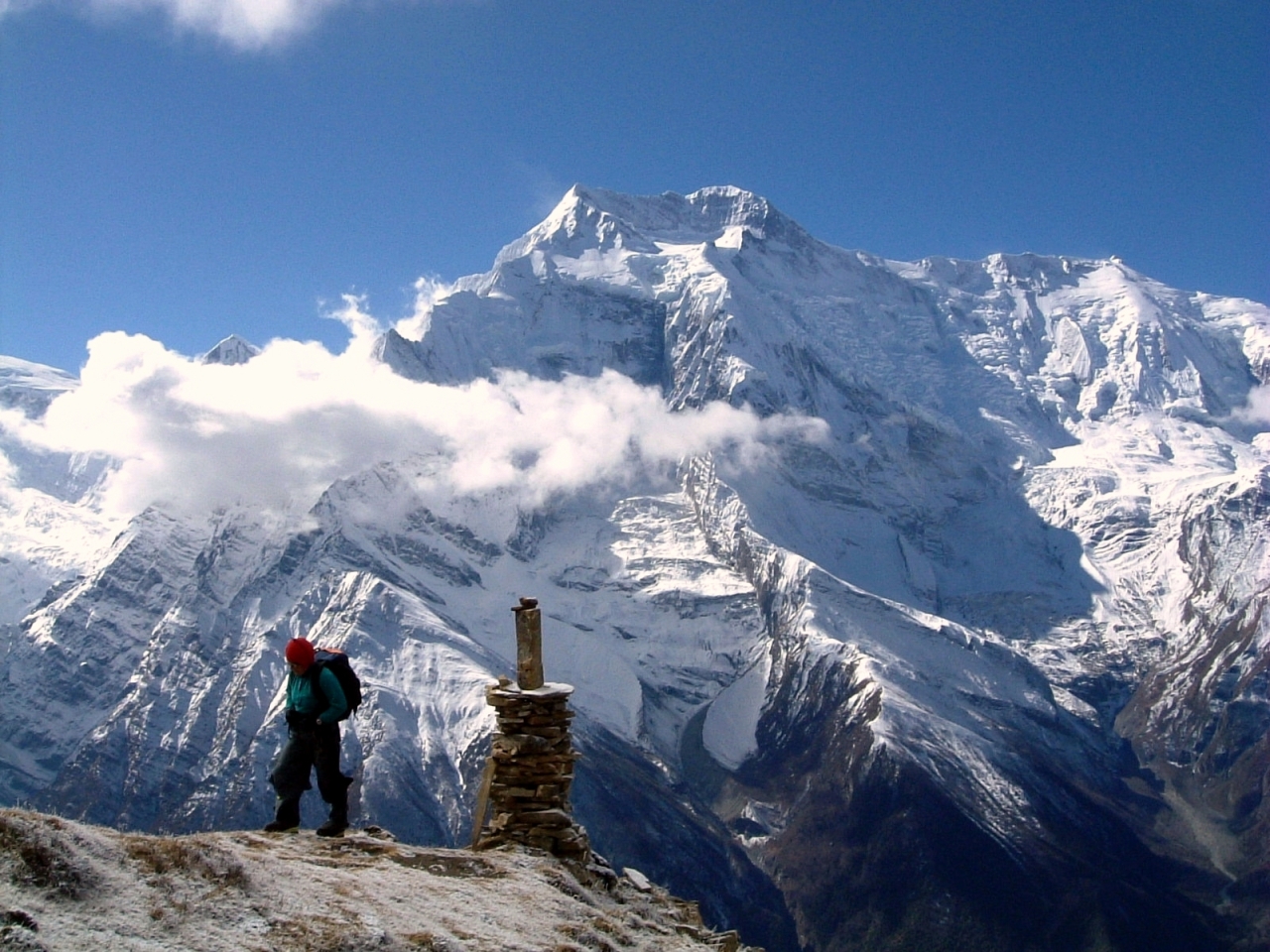Island Peak Climbing – 16 Days
Conquering New Heights: Island Peak Climbing Adventure
Introduction:
Embarking on a thrilling journey to the Himalayas, Island Peak climbing offers a challenging yet rewarding experience for adventure enthusiasts. Located in the Everest region of Nepal, Island Peak, also known as Imja Tse, stands tall at an impressive elevation of 6,189 meters (20,305 feet). With breathtaking landscapes and awe-inspiring views, this expedition is perfect for those seeking an unforgettable mountaineering adventure. In this blog, we will delve into the details of Island Peak climbing, highlighting its significance, challenges, and the mesmerizing beauty that awaits climbers.
Island Peak: A Jewel Amidst the Himalayas
Island Peak, named so due to its striking resemblance to an island in a sea of ice, is a popular choice for climbers who wish to test their skills and endurance. Nestled in the Sagarmatha National Park, a UNESCO World Heritage Site, this peak offers a panoramic view of the surrounding giants like Nuptse (7,861m), Lhotse (8,516m), and the mighty Everest (8,848m).
The Adventure Begins: Preparation and Acclimatization
Before embarking on the Island Peak climbing expedition, it is crucial to prepare both physically and mentally. Building stamina, cardiovascular fitness, and strength through regular exercises and training will help climbers tackle the demanding ascent. Additionally, spending a few days acclimatizing in the nearby towns of Namche Bazaar and Dingboche helps adjust to the high altitude, minimizing the risk of altitude sickness.
The Route: A Journey of Challenges and Rewards
The Island Peak climbing route typically starts from Lukla, a small town accessible by a thrilling flight from Kathmandu. Trekkers then follow the renowned Everest Base Camp trail until they reach Chhukung, a picturesque village at 4,730 meters. From Chhukung, climbers head towards the Island Peak Base Camp, which lies at an elevation of 5,200 meters. The base camp provides a mesmerizing setting, surrounded by glaciers and towering peaks.
Technical Aspects: The Summit Push
As climbers venture higher, they encounter a section of the climb that requires technical skills. Fixed ropes, crampons, ice axes, and other necessary mountaineering equipment become crucial for navigating the challenging terrain. Climbers face steep slopes, icy ridges, and crevasses, making this section both thrilling and demanding. Proper guidance from experienced Sherpas or mountaineering guides ensures a safe and successful summit push.
The Ultimate Triumph: Reaching the Summit
The final push towards the summit of Island Peak is both exhilarating and breathtaking. Standing atop the peak, climbers are rewarded with unparalleled views of the Everest region and its majestic surroundings. The feeling of accomplishment and the sense of being on top of the world make the entire journey worthwhile. Photographs capturing this moment become lifelong mementos, reminding climbers of their incredible achievement.
A Glimpse of the Himalayan Culture
Aside from the physical challenges and natural beauty, Island Peak climbing provides an opportunity to immerse oneself in the rich Sherpa culture. Throughout the trek, climbers pass through traditional Sherpa villages, monasteries, and prayer flags, getting a glimpse into the unique way of life in the Himalayas. Interacting with the locals and experiencing their warm hospitality adds depth to the overall experience.
Safety First: Hiring a Reliable Guide or Agency
Ensuring safety during the Island Peak climbing expedition is of utmost importance. Hiring a reputable and experienced guide or agency not only provides climbers with the necessary equipment but also ensures a well-planned itinerary, adequate acclimatization, and emergency support. Their expertise and local knowledge contribute significantly to the overall safety and success of the climb.
Best Time to Conquer Island Peak
The weather and climbing conditions play a crucial role in determining the best time for Island Peak climbing. The preferred seasons are spring (April-May) and autumn (October-November). During these periods, the weather is relatively stable, with clear skies and milder temperatures. Climbing in the offseason, such as during winter or monsoon, is not recommended due to harsh weather conditions and increased risks.
Physical and Mental Preparation
Island Peak climbing demands physical fitness and mental strength. Engaging in regular cardiovascular exercises, strength training, and endurance-building activities helps climbers prepare their bodies for the demanding ascent. Mental preparation is equally vital, as climbers must be mentally resilient to face challenges, overcome obstacles, and stay focused during the expedition.
Conservation and Responsible Tourism
As adventurers, it is our responsibility to protect and preserve the pristine beauty of the Himalayas. Following Leave No Trace principles, respecting local customs and traditions, and minimizing our environmental impact are crucial. Choosing eco-friendly accommodations, avoiding single-use plastics, and supporting local communities through responsible tourism practices contribute to the sustainable development of the region.
Conclusion:
Island Peak climbing is an extraordinary adventure that tests the limits of both physical and mental endurance. From the awe-inspiring landscapes and breathtaking views to the rich cultural experiences, this expedition offers a unique opportunity to explore the wonders of the Himalayas. However, it is essential to approach the climb with adequate preparation, reliable guidance, and a deep sense of respect for nature and local communities. With determination, perseverance, and a spirit of adventure, conquering Island Peak will undoubtedly leave climbers with memories that will last a lifetime. So, lace up your boots, embrace the challenge, and embark on a remarkable journey to the top of the world.
Best season for conquering Island Peak Climbing are Autumn and Spring
Island Peak Climbing is one of the most popular trekking peaks in Nepal and it consumes at least 18 days to accomplish the climb. As in Nepal, till Mid-September there remain slight rainy days, so the rainy season is the worst time to climb up. Since, extreme weather, blizzards, and avalanches are deadly and cause to have fatal risks, winter is also not advisable. But, in Early Autumn ( Mid- Sep to Mid Nov) in Nepal, the sky is clear with mind-blowing visibility, less thick snow in the mountains, and a moderate climate which makes the trekking easy, possible, and memorable. This time is more appropriate than late Autumn from the perspective of time and weather because late Autumn is colder than early Autumn in Nepal. Clouds have gone, days are sunny, and horizons have the strongest visibility, even many mountains are visible from Kathmandu Valley in Autumn.
Another best time is Spring ( Mid March to Mid May). This time is the best because Spring prospers the whole environment of the Khumbu region with greenery, blooming rhododendron, and superb bio-diversity. A great combination of a blooming environment with a moderate climate really fascinates the trekkers. The mountaineers who admire nature, culture, and high snow-capped mountains, Spring is the best time for them to accomplish Island Peak Climbing, situated at an altitude of 6189m from where they can have a close look at the magnificent stunning mountains of Khumbu region like Mt. Ama- Dablam, Nuptse, Lhotse, Makalu including the highest mountain in the world, Mt Everest locally known as Sagarmatha and many numerous of Khumbu region in 360° landscape.
Meals and Accommodation for Island Peak Climbing
Health is wealth. To have a healthy body during Island Peak Climbing that goes on for many days of trails, good hygiene food, and sound sleep are essential. A hygienic balanced diet and sound sleep make your body healthy and energetic. To achieve the incredible experience of Island Peak Climbing, a healthy body is a must. This is the first requirement to succeed in peak climbing. Climbing the mountains of the Himalayas is not a joke, it is a challenge of the Himalayas. Extreme weather, avalanches blizzards, crevasses, high altitude sickness, and frostbite are some hindrances that climbers have to face. To overcome these hindrances climbers must be physically fit and fine. The exhausted, properly sleepless body can easily terminate your mission of conquering Island Peak Climbing. Therefore, to provide you with a hygienic balanced diet, and sound sleep, Khumbu Region has made everything available on the foothills of the high Himalayas. For this, numerous insanely attractive well- facilitated hotels, lodges, restaurants, and teahouses are available to provide you with good food and sound sleep on your paths.
To accomplish Island Peak Climbing, trekkers have to reach first Lukla by plane then their trails commence from Lukla to Phakding to Namche Bazaar to Tengboche to Dingboche to Chukung to Base Camp to High Camp. For acclimatization, they have to reach Everest Base Camp and Kalapather. Except for Base Camp and High Camp, hotels, restaurants, and teahouses available on the paths provide the trekkers with healthy delicious meals and warm comfortable beds along with internet access. In places like Lukla, Phadking, and Namche Bazaar, trekkers can have food as per the menu like in Kathmandu, and soft or hard drinks. But the teahouses of upper places have fewer items in comparison to the down. But they have enough items of hot drinks, soups, and main courses to satisfy the trekker’s appetite and make them energetic. Even hard drinks or soft drinks are also available. But the foods are slightly expensive and taste different in comparison to Kathmandu. The beautiful well-facilitated hotels, lodges, restaurants, and teahouses also provide the facilities like taking showers and electric blankets for which they have to pay extra.
But in the base camp and high camp, as there aren’t any teahouses available, tents are set up and a staff or a cook of the group prepares meals for trekkers. Hence, from the begging to the end of the trek, the meals and accommodation are arranged. There won’t be any problems with meals and accommodation. According to the trekkers’ wish, either Nepali daily diet Dal ( lentil soup), bhat( rice), tarkari ( vegetables), saag ( green vegetable), achar ( pickle) at lunch and dinner which is a balanced diet and gives carbohydrates, proteins, vitamins, fat, fiber, minerals, or wish to have different foods that are normally available in hotels, restaurants, and teahouses either veg or non-veg, they can have.
Highlights of Island Peak Climbing
- Island Peak Climbing is an incredible life experience of peak climbing that prepares mountaineers for future expeditions, and rewards climbers’ determination to reach the top with breathtaking marvelous views of the world’s highest mountains of the Himalayas in 360°.
- Ama- Dablam ( 8812m), Baruntse (7162m), Nuptse ( 7861m), Lhotse (8516m), Makalu ( 8481m) including the world’s highest mountain, Mt Everest ( 8848m) and many other stunning mountains can be visible.
- Island Peak Climbing allows the trekkers to learn and observe the culture, people, tradition, and biodiversity of the Khumbu region during the trekking that starts after landing at Tenzing- Norgay airport at Lukla and moves upwards along the rough rocky paths.
- At attractive and well-facilitated hotels, lodges, restaurants, and teahouses in different areas of Khumbu region provide nutritious hygienic meals and cozy bedrooms to relax the trekkers with internet access. And camps are set up in base camp and high camp, and meals are prepared by a cook
- Moreover, rivers, pine forests, suspension bridges, rhododendron trees, and the Himalayan monal energize trekkers and make their trekking memorable and meaningful.
- Fit and fine body, proper acclimatization, previous mountaineering experience, training, and all required equipment and gear make the climb easier.
- All the equipment and gears like crampons, ice axe, harness, descenders/ super 8, ascender/ jumar, carabiner/karabiner, ropes, prusik rope, tape slings, belay device, ice screws, trekking poles, snow bar, expedition body wear, hand wear, footwear are must.
Note: Keep a grace day to ensure you climb the summit even if you fail to do so the first day because of bad weather.
Trip Difficulty: Challenging
Requires prior experience of high-altitude trekking. The altitude may get over 6000 m and may require some climbing skills, such as; cramponing, ice-axing etc.
Service Level: Standard
Comfortable tourist-class accommodations with character; mix of public and private transport. Star Standard meals at Kathmandu!
| Day 1 | Arrive in Kathmandu/Transfer to Hotel | – |
| Day 2 | Fly to Lukla and Trek to Phakding 2610 m | 6 hours |
| Day 3 | Trek to Namche 3,440 m | 5 hours |
| Day 4 | Acclimatization at Namche Bazaar | – |
| Day 5 | Trek to Tengboche 3,860 m | 6 hours |
| Day 6 | Trek to Dingboche 4,410 m | 5-6 hours |
| Day 7 | Acclimatization at Dingboche | – |
| Day 8 | Trek to Chhukung valley | 3 hours |
| Day 9 | Trek to Island Peak Base Camp | 4 hours |
| Day 10 | Summit Island Peak & Trek back to Chhukung | 8 hours |
| Day 11 | Spare Summit Day | – |
| Day 12 | Trek to Tengboche | 4-5 hours |
| Day 13 | Trek to Namche Bazaar | 4-5 hours |
| Day 14 | Trek to Lukla | 3 hours |
| Day 15 | Fly back to Kathmandu | – |
| Day 16 | Depart from Kathmandu | – |
Includes
- Arrival airport pick and drop.
- Dinner in one of the finest diners in Kathmandu before and after the trek.
- 2 Nights at ★★★ hotel in Kathmandu.
- Entire land commute during the trip
- Domestic flight fare, airport tax and domestic transfer.
- Standard Tea-house/ Lodge during the trek.
- (B,L,D) Meals during the trek.
- 1 Climbing Guide (Licensed & First Aid Trained) and Porters
- Mountain climbing and other related permits
- Private High-Altitude Tents
- Kitchen cookware and staffs
- Duffel Bag
- Climbers’ Certificate (Issued by Government)
- Arrangement of Rescue/Medical Helicopter service; covered by your Insurance agency.
Excludes
- Visa & Processing Fee
- International flight fares
- Meals other than during the trek and dinners in Kathmandu
- Mineral water and refreshments during the trek
- Personal gears and equipment
- Travel insurance (Cover Helicopter evacuation and Trip Cancellation charges)
- Guide/Porter Tipping
Group Climbing Gear – We provide
- Rope, Harness, Ice-axe, Carabineers, Crampons
- F-8, Jumper, Helmet, Ice-Bar, and Ice-screw, Climbing permit
- Tent, foam mattress, sleeping bags, PAC
Testimonials
Great experience!! I did the Island Peak Climb, everything was very well organised and our climbing guide was one of the most experienced! They reply very promptly and give competent answers! ~Olivia Hoffman (Switzerland)
Additional information
The above information is a guide and standard template of what we provide. Our trip can be customized at your request to accommodate your specific requirements.
Responsible Tourism
Currently, we help raise fund and donate it to help build schools and shelters at the Earthquake stricken regions of Central Nepal province. You can join the cause help donate or volunteer to teach at the primary level schools. Visit Community Center for more information.
- Arrival in Kathmandu At your arrival in Kathmandu, a member of our team will greet and receive you at the airport. You will be transferred to your hotel. Our representative will brief on your arrival about the trip. The rest of the day is yours. The evening we be spent enjoying complimentary local dinner one of the finest local diner with cultural program.
- Fly to Lukla & Trek to Phakding Lukla is the gateway to Everest Base Camp. After a scenic half an houyr flight to Lukla Airport, the journey will begin. The first day of the trek will be more like a warm up. It will take you to Phakding village, just above Lukla. You can spend the rest of the day enjoying the local scenery.
- Trek to Namche Bazaar The trek will ascend up to the Dudh Koshi Valley. After a few hours of hike, you will arrive at entrance of Sagarmatha National Park in Monjo. The next and the final stop will be at Namche Bazaar. Namche is the highlight of the trek. The village bustling with people and lodges feels more like a city.
- Acclimatization Day Higher the altitude, thinner the air! You need to gain altitude slowly and steadily so that we get enough time to acclimatize en route. Today, you hike to Syangboche village, just above Namche and return back to Namche to spend the rest of the day.
- Trek to Tengboche The trek follows the gradual trail with few short up and downs overlooking magnificent view of the great giant snow peaks; Everest, Nuptse, Lhotse, Ama Dablam and Thamserku. After few hours of steady uphill hike, you’ll reach the most anticipated destination, Tengboche. The monastery located at Tengboche s the highest in Nepal, and is holds a special place for the Sherpas living in the Khumbu region. If you arrive here in Autumn, you may even get to witness the Mani Rimdu festival.
- Trek to Dingboche Dingboche is a next village from Tengboche. Passing through the typical Sherpa villages like Pangboche and Shomare, you reach Dingboche in a matter of few hours.
- Acclimatization at Dingboche It is acclimatization and an important day. You’ll get used to the thin air of above 4,000 meters. It is essential to spend some time here to prepare yourself for the further trek. You can also take some couple of hours to hike up to the nearby Chhukung village and return.
- Trek to Chhukung valley Today, you have a shorter day. After breakfast, you head further east and walk 2-3 hrs uphill to reach the Chhukung village. You can spend the rest of the day here and prepare for the climb next day. It’s important that you acclimatize and grasp much knowledge about the weather, snow and climbing skills.
- Trek to Island Peak Base Camp Today, you head upwards, passing besides the Lhotse Glacier. A zig-zag route through the Imja and Lhotse glacier moraines leads to a wide valley flanking the south western side of the Island peak. You’ll reach the Island peak base camp and rest overnight.
- Island Peak Summit/Trek back to Chhukung It’s a Big Day. Summit days are always overwhelming. You start early, probably around 2 am and start climbing up. This is not difficult but there are several short rock steps to climb before you emerge on the right side of the gully. The route then follows a ridgeline, which leads to an exhilarating and exposed traverse onto the snout of the summit glacier. A guide will fix the rope and assist your for climbing. The final ascent isn’t much difficut and provides an exciting feeling. You can spend some time at the top a return back the same way. The day ends at Chhukung village.
- Spare Summit Day An extra day is kept to ensure you summit the peak if you are unable to do so the first day.
- Trek to Tengboche The trek will be comparativley easier than before. You’ll be heading down to Tengboche village. The trail leads through the vast forest of pine and rhododendron, before arriving at Tengboche. The Tengboche monastery is the highlight of this trek. Built more than 100 years ago, locals consider it an important place for homage. You can enter the premise and witness the monks and their lifestyle in person. If you visit the place in autumn, you might even get to celebrate the local festival of Mani Rimdu.
- Trek to Namche Bazaar From Tengboche, you head back down the same trail towards Namche Bazaar. Even though, you don’t reach the base camp, the magnificent view of Everest will be visible through the journey. You spend the night at the Namche along with other trekkers.
- Trek to Lukla Lukla will be the final stop of your trek. A final leg of the trip, you might overcome with mixed feelings. It’s a day to throw a small party. The evening and the night will be marked with celebrations that will include a lot of singing and dancing. You will spend the night at Lukla and fly out early morning.
- Fly back to Kathmandu You can take the earliest possible flight back to Kathmandu. One of our representative will transfer you to your hotel. Later the evening, we will treat you with a complimentary dinner, a set of exquisite Nepalese cuisines.
- Departure from Kathmandu You will be transferred to the Airport to catch your flight back home.
-
Package Price Date
Island Peak Climbing – 16 Days
Get this trip at $ 2149USDTrips Details
| Trip Length | 16 days | |
| Climb Length | 01 days | |
| Activities | Trekking, Climbing | |
| Max. Altitude | 6,189 meters (20,305 ft) | |
| Trek Style | Tea-house (Lodges), Camping | |
| Meal | Full board on trip | |
| Accommodation |
|
|
| Transportation | Private Vehicle, Domestic Flight | |
| Best Month | February, March, April, May, September, October, November | |
| Required (Min) | 2 Person |
- Guaranteed Departure
- Bigger Group, Bigger Discount
- Customizable Trips
- All Inclusive/GAP Trip Available
Send your inquiry via the form below
